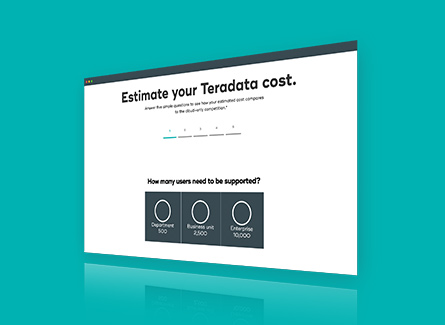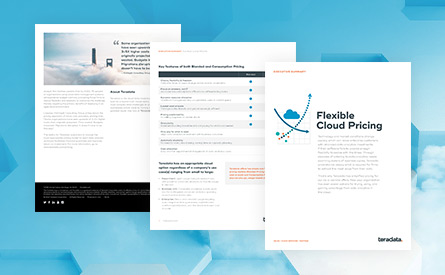Estimate future budgets based on your workloads
To estimate your actual budget requirements, look at your production use cases that show workloads at scale.
Running data analytics in the cloud can be surprisingly expensive. Analyst firm Gartner predicts that by 2022, 75 percent of organizations using cloud data management systems will experience budget overruns. Let us help you better understand the actual cloud data analytics costs, what pricing works best for your business, and how to avoid surprises.
Learn how to choose the right data analytics solution in the cloud based on these 6 factors for success.
Estimate future budgets based on your workloads
To estimate your actual budget requirements, look at your production use cases that show workloads at scale.
Get expert guidance when migrating to the cloud
Don’t listen to claims that migrating to the cloud is simple—it’s a complex process that can drive budget overruns.
Avoid unexpected costs and keep your projects alive
As user demand changes, automatic scaling can deliver an unexpected bill that can kill your project and your reputation.
Meet service level goals with software first
You need mature software that can be optimized to meet service level goals without the incremental cost of compute resources.
Demand flexible cloud pricing
Flexible pricing will enable you to manage your costs and meet the needs of ever-changing user demand.
Measure price-performance
Look for lowest cost per query. Vendors deliver multiple different metrics to make their solutions look the most attractive.
Learn about Teradata’s flexible pricing and how it can help you get the most value out of your data.

Answer five simple questions to estimate which pricing is right for your cloud needs.

Wherever you are on your cloud journey, these pricing options are designed to fit the data demands of your organization.
Starting at $5 per hour compute, and 19 cents per terabyte per hour storage, Teradata Vantage offers refreshingly affordable cloud pricing—no matter what you require from your data analytics in the cloud.
Initial startup savings of cloud-only data warehouses can quickly devolve into unexpected—and unwelcome—cost spikes at scale.
The ability for Teradata customers to choose the most appropriate pricing for each data analytic workload facilitates financial guardrails and improves your organization’s return on investment.
Blended Pricing means there’s no billing surprises or sticker shock, while Consumption Pricing means there’s complete freedom to only pay for what is used.


In this side-by-side comparison, the difference between Vantage and the competition is clear. Only Vantage offers the choice, truly predictable and transparent pricing, and elasticity your needs, PLUS the lowest pricing at scale.
| Cloud-only data warehouse | Teradata Vantage | |
|---|---|---|
| Get started quickly without ongoing obligation |
Start quickly without ongoing financial obligation
Cloud-only data warehouse
|
Start quickly without ongoing financial obligation
Teradata Vantage
|
| Start small and grow |
Can start small and scale to a mid-size system
Cloud-only data warehouse
|
Can start small and scale to an enterprise-size system
Teradata Vantage
|
| Seamlessly allocate user costs by department (chargeback) |
Multiple systems may be needed to separate costs
Cloud-only data warehouse
|
All users can be on the same system with full transparency for chargebacks
Teradata Vantage
|
| Scale compute as little as needed in small steps |
Scale only in increasingly bigger steps which are often larger than needed
Cloud-only data warehouse
|
Scale incrementally based on usage to avoid unused resources
Teradata Vantage
|
| Choice of pricing models for different workloads |
Limited to pay-as-you-go pricing
Cloud-only data warehouse
|
Flexible choice: Blended Pricing (reserved) and Consumption Pricing (pay-as-you-go)
Teradata Vantage
|
| Lowest cost at scale |
Cost per query rises dramatically as query volume increases
Cloud-only data warehouse
|
Cost per query remains low as query volume increases
Teradata Vantage
|
| Pay only for what you need with granular scalability |
Pay for what is provisioned, even if much larger than needed
Cloud-only data warehouse
|
Pay only for what you use with granular scaling
Teradata Vantage
|
| Only pay for queries, loading, and storage |
Pay for what is provisioned, even if unused and too large
Cloud-only data warehouse
|
Only pay for resources actually used (Consumption Pricing)
Teradata Vantage
|
| Enjoy predictable pricing without billing surprises |
Cost “surprises” after discovering how much automatic scaling costs
Cloud-only data warehouse
|
Sleep well knowing that costs remain bounded by financial guardrails (Blended Pricing)
Teradata Vantage
|
| Enjoy automatic elasticity and never worry about system size |
Guess at the maximum size you might need for automatic scaling
Cloud-only data warehouse
|
Allows Teradata to monitor and automatically adjust system size for you based on usage (Consumption Pricing)
Teradata Vantage
|
| Reuse prior on-premises investments and IP for new deployments |
Start over, recode, and retrain just to get to your previous baseline
Cloud-only data warehouse
|
Gain positive ROI from Day 1 with your current data and tools
Teradata Vantage
|
We’re not the only ones talking about transparent cloud pricing and the prevalence of “gotchas” in the industry.
Analyst report
McKnight Consulting says determining price-performance in the cloud is the “ultimate success metric”
Analyst report
Teradata is the connected multi-cloud data platform for enterprise analytics company - and we're named a leader in the 2020 Gartner Magic Quadrant for Cloud Database Management Systems